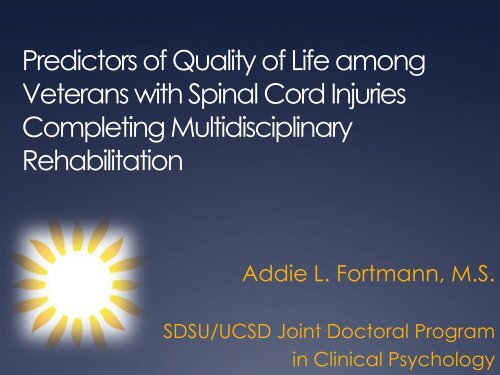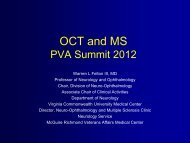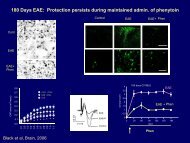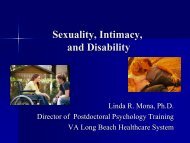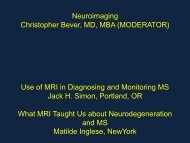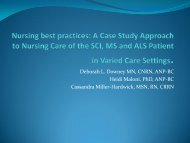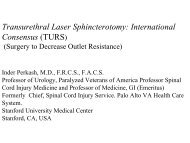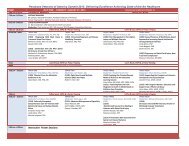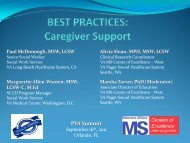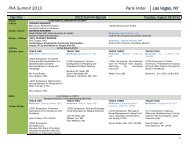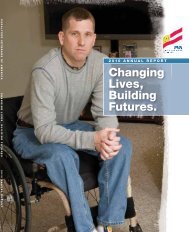Addie Fortmann, MS
Addie Fortmann, MS
Addie Fortmann, MS
You also want an ePaper? Increase the reach of your titles
YUMPU automatically turns print PDFs into web optimized ePapers that Google loves.
Predictors of Quality of Life among<br />
Veterans with Spinal Cord Injuries<br />
Completing Multidisciplinary<br />
Rehabilitation<br />
<strong>Addie</strong> L. <strong>Fortmann</strong>, M.S.<br />
SDSU/UCSD Joint Doctoral Program<br />
in Clinical Psychology
Special Thanks to Coauthors<br />
‣ Thomas Rutledge, Ph.D. 1,2<br />
‣ Corey McCulloch, Ph.D. 1,2<br />
‣ Smriti Shivpuri, M.S. 3<br />
‣ Anne Nisenzon, Ph.D. 1<br />
‣ Jeri Muse, Ph.D. 1,2 1<br />
VA San Diego Healthcare System<br />
2<br />
UCSD, Department of Psychiatry<br />
3<br />
SDSU/UCSD Joint Doctoral Program in Clinical Psychology
DISCLOSURES SLIDE<br />
‣ This continuing education activity is managed and<br />
accredited by Professional Education Service Group.<br />
‣ The information presented in this activity represents the<br />
opinion of the author(s) or faculty.<br />
‣ Neither PESG, nor any accrediting organization endorses<br />
any commercial products displayed or mentioned in<br />
conjunction with this activity.<br />
‣ Commercial Support was not received for this activity.<br />
‣ No others have financial interests or relationships to<br />
disclose
LEARNING OBJECTIVES SLIDE<br />
‣ At the conclusion of this activity, the participant will<br />
be able to:<br />
‣ Describe change in quality of life among Veterans<br />
undergoing multidisciplinary rehabilitation for SCI.<br />
‣ Identify predictors of quality of life among Veterans at<br />
discharge from multidisciplinary rehabilitation for SCI.<br />
‣ Determine whether predictors of quality of life among<br />
Veterans with SCI differ across meaningful subgroups.
OUTLINE<br />
‣ Overview<br />
‣ Methodology<br />
‣ Findings<br />
‣ Consideration of the Bigger Picture<br />
‣ Closing
‣ SCI is a life-altering event<br />
OVERVIEW<br />
‣ Affects physical functioning, social relationships, role fulfillment,<br />
and self-perception<br />
‣ Initial rehabilitation is critical to help<br />
patients acquire the knowledge and<br />
skills necessary to live a satisfying life.<br />
‣ Early post-injury adjustment predicts<br />
long-term adjustment to SCI.<br />
‣ QOL is a central goal of SCI rehabilitation.<br />
‣ Assessing and predicting QOL outcomes after<br />
SCI has grown in importance.
DEFINING DISABILITY<br />
…some history<br />
‣ 1980: International Classification of Impairments,<br />
Disabilities, and Handicaps (ICIDH):<br />
‣ Impairment<br />
‣ Level and completeness of SCI<br />
‣ Disability<br />
‣ The restriction/lack of ability to perform within “normal”<br />
ranges<br />
‣ Handicap<br />
‣ A disadvantage that limits/prevents the fulfillment of<br />
“normal” roles
DEFINING DISABILITY<br />
. . .more recently<br />
‣ 2002: International Classification of Functioning,<br />
Disability, and Health (ICF)<br />
‣ Impairment<br />
‣ organ/body level<br />
‣ Activity Limitation<br />
‣ person level<br />
‣ Participation Restriction<br />
‣ societal level<br />
‣ Disability reflects ‘dysfunctionality’ at one or more levels.
DEFINING DISABILITY<br />
. . .more recently
Meta-Analysis: DISABILITY AND QOL<br />
‣ 1997: Dijkers, M. Quality of life after spinal cord injury: a meta<br />
analysis of the effects of disablement components. Spinal<br />
Cord.<br />
‣ Disablement was defined according to 1980 ICIDH<br />
conceptualization.<br />
‣ Reviewed 22 independent studies; average N =102.<br />
‣ Conclusions:<br />
ASSOCIATIONS WITH QOL (r)<br />
Impairment: Weak, rarely statistically significant [95% CI -0.12; 0.02]<br />
Disability: Somewhat stronger, but inconsistent [95% CI -0.27; -0.14]<br />
Handicap: Strongest and fairly consistent [95% CI -0.48; -0.17]
DISABILITY AND QOL<br />
‣ Limitations of Existing Research. . .<br />
‣ Meta-analysis collapsed across civilian and Veteran<br />
samples.<br />
‣ Veterans represent a disproportionate number of individuals<br />
in the US with SCI.<br />
‣ Conclusions about relative predictive utility were drawn<br />
across very diverse studies.<br />
‣ Cross-sectional design<br />
‣ Conducted at some point after initial<br />
inpatient rehabilitation
CURRENT STUDY<br />
‣ Aim 1: Describe change in QOL from pre- to postrehabilitation.<br />
PRE<br />
QOL<br />
POST<br />
QOL<br />
‣ Aim 2: Compare indicators of impairment, activity,<br />
and participation in prospectively predicting QOL<br />
post-rehabilitation.<br />
PRE<br />
Impairment,<br />
Activity,<br />
Participation<br />
POST<br />
QOL
METHODS<br />
‣ 118 Veterans entered CARF-accredited, acute inpatient<br />
rehabilitation for SCI at the SD VA Medical Center<br />
between 1998-2010.<br />
‣ Rehabilitation:<br />
‣ Individualized<br />
‣ Lasted up to several months<br />
‣ Involved many SCI-specific providers<br />
‣ Medicine, dietetics, nursing, psychology, social work, PT, OT,<br />
recreation therapy, speech therapy, etc.<br />
‣ IRB approval was obtained to conduct analyses.
MEASURES: QOL<br />
‣ Satisfaction with Life Scale (SWLS) was completed at<br />
admission and discharge.<br />
‣ Veteran’s subjective (global) assessment of his/her<br />
quality of life according to personally chosen criteria<br />
(i.e., “subjective QOL”).<br />
‣ Assesses how satisfied individuals are with their present<br />
status as compared to a standard each individual sets<br />
for him/herself.<br />
‣ 5 items, each scored 1 (strongly disagree) to 7<br />
(strongly agree).<br />
‣ Possible scores ranged from 5 to 35
MEASURES: QOL<br />
STRONGLY SLIGHTLY NEITHER AGREE SLIGHTLY STRONGLY<br />
DISAGREE DISAGREE DISAGREE OR DISAGREE AGREE AGREE AGREE<br />
‣ 1) In most ways my life is close to my ideal.<br />
‣ 2) The conditions of my life are excellent.<br />
‣ 3) I am satisfied with my life.<br />
‣ 4) So far I have gotten the important<br />
things I want in life.<br />
‣ 5) If I could live my life over, I would<br />
change almost nothing.
MEASURES: Disablement<br />
‣ Impairment:<br />
‣ Injury level (tetraplegia = 1; paraplegia = 0)<br />
‣ Completeness of injury (ASIA Impairment scale (A/complete<br />
= 1 to E/normal = 5).<br />
‣ Activity: Functional Independence Measure (FIM)<br />
‣ 18 items forming 3 subscales<br />
‣ Motor, Elimination, Cognition<br />
‣ Participation:<br />
‣ Craig Handicap Assessment and Reporting Technique<br />
(CHART)<br />
‣ 27 items forming 5 domains<br />
‣ Physical Independence, Mobility, Occupation, Social<br />
Integration, Economic Self-Sufficiency
RESULTS: Sample Characteristics<br />
Characteristic<br />
M (SD)<br />
Age (yrs) 43.2 (17.5)<br />
Percent<br />
Male 97.5%<br />
Caucasian 65.3%<br />
Admitted ≤ 60 days post-injury 80.0%<br />
Employed for wages 43.2%<br />
SU/psychiatric diagnosis 20.3%<br />
Sustained SCI in combat 2.5%<br />
Mechanism = MVA 29.7%
RESULTS: Study Variables<br />
Impairment<br />
Percent<br />
Tetraplegia 54.7%<br />
ASIA A 37.9%<br />
Activity<br />
M (SD)<br />
Cognition 31.4 (3.9)<br />
Motor 24.5 (13.5)<br />
Elimination 4.2 (3.8)<br />
Participation<br />
M (SD)<br />
Physical independence 98.6 (7.2)<br />
Mobility 94.3 (16.9)<br />
Occupation 85.4 (29.0)<br />
Social integration 93.4 (16.4)<br />
Economic self-sufficiency 87.2 (23.1)
RESULTS: Change in SWLS<br />
‣ GROUP LEVEL<br />
‣ p >.10<br />
SWLS<br />
Mean (SD)<br />
Admission 22.7 (7.3)<br />
Discharge 21.5 (7.8)<br />
‣ INDIVIDUAL LEVEL<br />
‣ Continuous<br />
‣ Range +17 to -22 points; Individual Mean Δ=+1.2 (6.0)<br />
‣ Categorical (scores ≥20 reflect “at or above average SWL”)<br />
‣ 14% at or above average to below average<br />
‣ 17% below average to at or above average<br />
‣ 69% remained in the same category
RESULTS: Change in SWLS
RESULTS: Predicting SWLS at Discharge<br />
BASELINE INDICATOR SWLS AT DISCHARGE (r)<br />
Impairment<br />
Injury level -0.04<br />
Injury completeness -0.02<br />
Activity<br />
Cognition 0.31*<br />
Motor -0.03<br />
Elimination 0.12<br />
Participation<br />
Physical independence 0.04<br />
Mobility 0.09<br />
Occupation 0.11<br />
Social integration 0.21*<br />
Economic self-sufficiency 0.16
RESULTS: Predicting SWLS at Discharge<br />
Linear regression model including predictors that were statistically<br />
significant at the bivariate step.<br />
PREDICTOR<br />
β<br />
Admission SWLS 0.65*<br />
Activity<br />
Cognition 0.17*<br />
Participation<br />
Social integration 0.01<br />
Economic self-sufficiency -0.02<br />
45%<br />
+2%
RESULTS: Exploratory Analyses<br />
‣ Fit of the FIM cognition (activity) predictor did<br />
not vary by meaningful subgroups. . .<br />
‣ Age median split<br />
‣ Tetraplegia vs. Paraplegia
RECAP OF FINDINGS<br />
‣ Marked variability was observed across individuals in<br />
the magnitude and direction of QOL changes.<br />
‣ Activity (cognition) and participation (social<br />
integration, economic self-sufficiency) predicted QOL<br />
at discharge.<br />
‣ Consistent with 1997 meta-analysis findings that disability<br />
and handicap were the strongest predictors of QOL.<br />
‣ When entered jointly, activity (cognition) emerged as<br />
the most robust predictor.<br />
‣ In contrast to 1997 meta-analysis findings that handicap<br />
was most consistently associated with QOL.
GRAND SCHEME OF THINGS. . .<br />
‣ Cognitive Impairment<br />
‣ Cognitive screening is a standard component of acute<br />
SCI rehabilitation at the VA Medical Center<br />
‣ Veterans referred for cognitive rehabilitation to reduce<br />
functional interference as indicated.<br />
‣ Cognitive assessment and rehabilitation<br />
tools must be flexible and incorporate<br />
modifications for SCI populations.
GRAND SCHEME OF THINGS. . .<br />
‣ Social Integration<br />
‣ Programs providing assistance in building new and/or<br />
mobilizing existing social support resources.<br />
‣ Support groups and peer-mentor programs<br />
encourage Veterans to integrate with<br />
others who are coping with similar<br />
adjustment difficulties.<br />
‣ Consistent with large body of<br />
research indicating the importance<br />
of social networks in health.
Importance of Early Adjustment<br />
‣ Directly targeting various aspects of emotional wellbeing,<br />
including perceived QOL<br />
‣ Rehabilitation Psychology 2011 Systematic Review<br />
‣ Supported the use of specialized CBT protocols in persons<br />
with SCI experiencing depression, anxiety, and<br />
adjustment/coping difficulties.<br />
‣ Telecounseling interventions<br />
‣ Increase access, time-efficiency, and cost-effectiveness<br />
‣ Valuable method for reaching pts with limited mobility<br />
‣ Shown to improve QOL, coping skills, community integration,<br />
and depression in individuals with SCI and other acquired<br />
physical disabilities.
Limitations<br />
‣ Findings pertain to a particular definition/measure<br />
of (subjective) QOL – life satisfaction<br />
‣ What about adjustment after inpatient<br />
rehabilitation?<br />
‣ Limitations of predictor and outcome measures<br />
‣ Focused narrowly on components of disablement
IN CLOSING<br />
‣ First investigation of the relative utility of impairment,<br />
activity, and participation in predicting QOL<br />
among Veterans completing acute rehabilitation<br />
for SCI.<br />
‣ Findings highlight potential targets for interventions<br />
aiming to improve QOL post-SCI among US<br />
Veterans.<br />
‣ Results suggest that rehabilitation settings should<br />
continue (or expand upon) programs targeting<br />
cognitive functioning and social integration.
THANK YOU!<br />
‣ If you would like to receive continuing education<br />
credit for this activity, please visit<br />
http://www.pesgce.com/PVA2012


